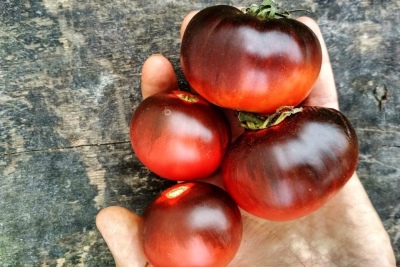
- Name synonyms: Red Charcoal
- Category: grade
- Growth type: indeterminate
- Appointment: fresh consumption
- Ripening period: mid-season
- Ripening time, days: 110-120
- Bush size: tall
- Bush height, cm: 180
- Bush characteristic: powerful
- Ripe fruit color: chocolate brown with large purple shoulders
Tomato Red Charcoal is a tall variety, can reach a height of 180 centimeters. The plant is indeterminate. Mature bushes are quite powerful and sturdy. This variety also has a second name, Red Charcoal.
Description of the variety
Tomato variety Red coal will allow you to get a large and full harvest. It can be used for outdoor cultivation and in greenhouses or greenhouses.
The main qualities of the fruit
The color of ripe fruits will be brown-chocolate with large purple "shoulders". The mass of one vegetable reaches 250 grams. The shape of tomatoes is round and flat-round.
One cluster contains 6-8 fruits. Their flesh is rather tender, its color is red-brown.
Taste characteristics
Tomatoes Red coal have excellent taste. They have a sweet taste and are most often used fresh.
Ripening and fruiting
This variety of tomatoes is mid-season. Harvesting can be done 110-120 days after planting.
Yield
This species is considered to be high yielding. From one healthy adult bush, you can collect up to 5.5 kilograms of fruit.
The timing of planting seedlings and planting in the ground
This variety should be sown for seedlings in early March. Planting in open ground is performed in April-May.

Growing tomato seedlings is an extremely important process, because it largely depends on whether the gardener can harvest at all. All aspects must be taken into account, from seedbed preparation to planting in the ground.
Landing scheme
When planting young seedlings, a distance of 50-80 cm between individual bushes should be observed.A distance of 60 to 100 cm should also be left between individual rows.

Growing and caring
First you need to prepare seedlings for planting. For this, seed is selected. It is better to pre-treat it in special disinfecting preparations, you can use fungicides.
For planting seeds, the required number of plastic containers is selected, you can also take simple disposable cups. At the same time, you should prepare the ground. Remember that it must be a little raw.
The land will need to be mixed with nutritious organic feed. The resulting mixture is distributed over all containers. After that, they begin to spread the seed material on top, deepening it a little.
You should wait until 2-3 leaves appear on young plants, then you can plant the vegetation in open soil. To do this, first prepare the landing holes.At the same time, it is better to pour organic fertilizing at the bottom of each pit. Sometimes ready-made complex fertilizers are used, which include all the main necessary nutritional components.
Seedlings should be planted carefully so as not to harm the roots. Landing is done with a lump of earth. After that, the land around the plants is watered abundantly.
In the process of growth and development, the bushes will need to be watered regularly. The amount of watering should be increased during dry periods. Up to five liters of warm clean water will need to be poured under each bush.
To achieve a more active development of the root system, it is also necessary to periodically loosen the soil after watering. It is better to use a layer of mulch, it will inhibit the growth of weeds. Often in this case, coniferous sawdust, well-dried straw are used.
If the tomatoes were planted in high-quality soil, then they will not need frequent feeding. It will be enough to fertilize the soil during planting, during flowering and after the formation of the ovary.
In this case, the last two dressings must necessarily contain a sufficient amount of potassium, magnesium and calcium. There should be a minimum amount of nitrogen in the substances, otherwise you can harm the plants during fruiting. It is worth remembering that the culture will also need pinching and bush formation.
Disease and pest resistance
Tomato variety Red coal boasts good resistance to various diseases and pests. It practically does not undergo late blight. And also the species has good immunity to gray rot.
Sometimes harmful insects (aphids, slugs) can be observed on the leaves and stems. In this case, all these organisms are harvested by hand, then the bushes are carefully processed, you can also use folk remedies (tinctures with wood ash, with crushed garlic heads, with grated household soap).
To avoid the appearance of various insects and diseases, preventive treatments should be carried out. For this, fungicides can be excellent. Most often, treatments are carried out by spraying. You can also use homemade folk compositions.




A plant needs different micronutrients at each stage of growth. All fertilizers can be divided into two groups: mineral and organic. Folk remedies are often used: iodine, yeast, bird droppings, eggshells.
It is important to observe the rate and period of feeding. This also applies to folk remedies and organic fertilizers.



























































































